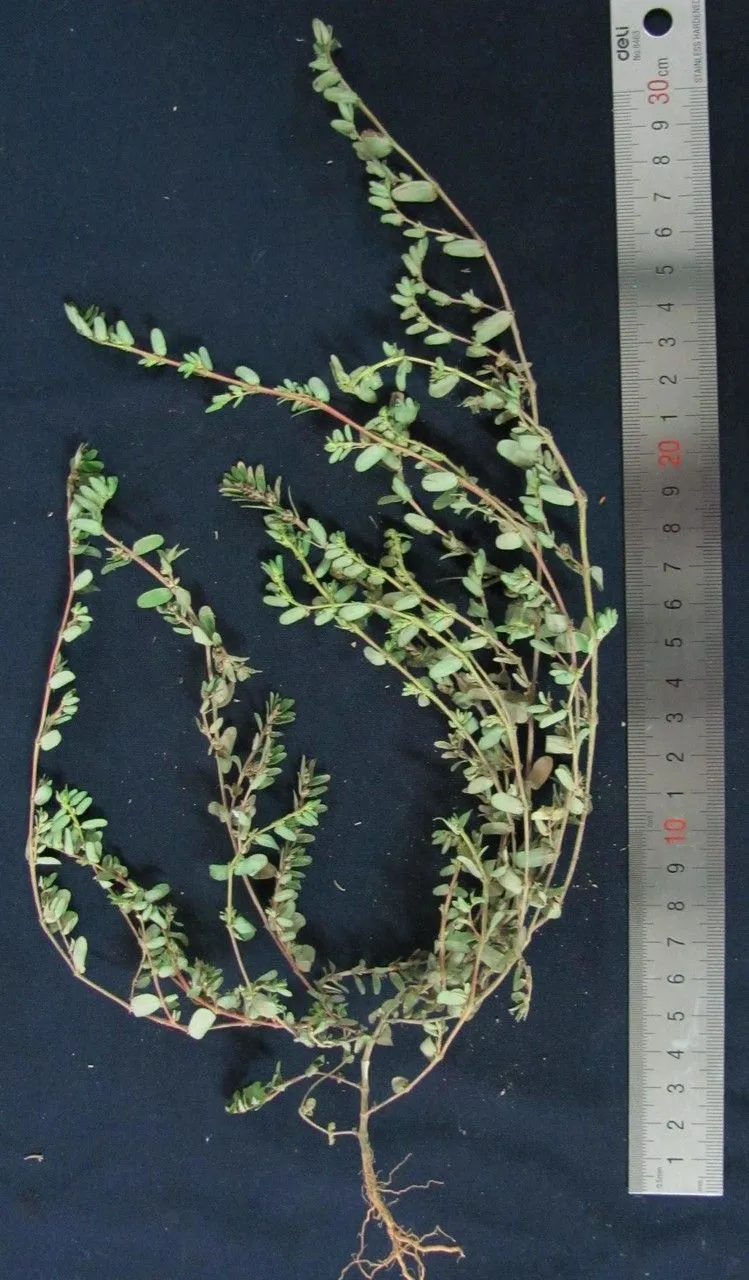
Author: L.
Bibliography: Sp. Pl.: 454 (1753)
Year: 1753
Status: accepted
Rank: species
Genus: Euphorbia
Vegetable: Unknown
Observations: Trop. & Subtrop. America
Chickenweed, scientifically known as Euphorbia thymifolia, is a fascinating member of the plant family Euphorbiaceae. This plant, first documented in the seminal work “Species Plantarum” in 1753 by the renowned botanist Carl Linnaeus, carries the weight of historical botanical exploration within its classification.
Noted for its presence in tropical and subtropical regions of America, Chickenweed thrives in climates that offer both warmth and ample moisture. Adapted to these environments, it often proliferates in disturbed soils, finding its niche in gardens, agricultural fields, and even along roadsides, where it can sometimes become a pervasive weed.
Euphorbia thymifolia is characterized by its small, delicate foliage, which bears a resemblance to that of thyme—a detail alluded to in its species name. Despite its modest appearance, Chickenweed is a resilient plant, capable of enduring less-than-ideal soil conditions. Its growth habit is typically low and spreading, creating a mat-like ground cover that can smother less competitive plants.
Understanding the botanical nuances of Chickenweed involves delving into its structural and reproductive traits. The plant produces minute flowers that are easily overlooked due to their size, epitomizing the often-unseen intricacies of nature’s designs. These flowers give way to tiny fruits, each encasing seeds that contribute to the plant’s reputation for rapid spread and persistence.
Euphorbia thymifolia holds a place in traditional medicine across various cultures within its native range. It has been utilized for its purported medicinal properties, a testament to the deep-rooted relationship between local flora and human health practices in tropical and subtropical America.
In summary, Chickenweed or Euphorbia thymifolia is a plant of both historical botanical interest and practical significance. Its ability to flourish in diverse conditions, coupled with its subtle yet resilient nature, makes it a notable species within the Euphorbiaceae family and an intriguing subject of study for botanists and plant enthusiasts alike.
Eng: gulf sandmat, chickenweed
Spa: golondrina
En: Chickenweed, Gulf sandmat, Thyme-leaf Broomspurge, Spurge
Fr: Euphorbe à feuilles de thym
Es: Golondrina
Taken Sep 29, 2015 by Nelson Zamora Villalobos (cc-by-nc)
Taken Sep 29, 2015 by Nelson Zamora Villalobos (cc-by-nc)
Taken Sep 29, 2015 by Nelson Zamora Villalobos (cc-by-nc)
Taken Apr 2, 2022 by Emanuele Santarelli (cc-by-sa)
Taken Sep 28, 2015 by OTS – Oviedo-Brenes, Federico (cc-by-nc-sa)
Taken Apr 2, 2022 by Emanuele Santarelli (cc-by-sa)
Taken Jan 7, 2022 by Enirald (cc-by-sa)
Taken Jan 7, 2022 by Enirald (cc-by-sa)
Taken Jan 7, 2022 by Enirald (cc-by-sa)
Taken Sep 28, 2015 by OTS – Oviedo-Brenes, Federico (cc-by-nc-sa)
Taken Sep 28, 2015 by OTS – Oviedo-Brenes, Federico (cc-by-nc-sa)
© copyright of the Board of Trustees of the Royal Botanic Gardens, Kew.
© copyright of the Board of Trustees of the Royal Botanic Gardens, Kew.
© copyright of the Board of Trustees of the Royal Botanic Gardens, Kew.
Taken Sep 28, 2015 by OTS – Oviedo-Brenes, Federico (cc-by-nc-sa)
Taken Aug 13, 2015 by OTS – Oviedo-Brenes, Federico (cc-by-nc-sa)
Taken Apr 17, 2019 by OTS – O. Vargas (cc-by-nc-sa)
Taken Aug 13, 2015 by OTS – Oviedo-Brenes, Federico (cc-by-nc-sa)
Taken Aug 13, 2015 by OTS – Oviedo-Brenes, Federico (cc-by-nc-sa)
Family: Myrtaceae Author: (F.Muell.) K.D.Hill & L.A.S.Johnson Bibliography: Telopea 6: 402 (1995) Year: 1995 Status:…
Family: Rubiaceae Author: Pierre ex A.Froehner Bibliography: Notizbl. Bot. Gart. Berlin-Dahlem 1: 237 (1897) Year:…
Family: Sapindaceae Author: Koidz. Bibliography: J. Coll. Sci. Imp. Univ. Tokyo 32(1): 38 (1911) Year:…
Family: Asteraceae Author: A.Gray Bibliography: Pacif. Railr. Rep.: 107 (1857) Year: 1857 Status: accepted Rank:…
Family: Fabaceae Author: Medik. Bibliography: Vorles. Churpfälz. Phys.-Ökon. Ges. 2: 398 (1787) Year: 1787 Status:…
Family: Aspleniaceae Author: (Cav.) Alston Bibliography: Bull. Misc. Inform. Kew 1932: 309 (1932) Year: 1932…